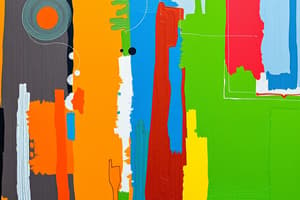Podcast
Questions and Answers
What is the role of colors in art according to color theory?
What is the role of colors in art according to color theory?
- They primarily determine the shape of the artwork.
- They serve as building blocks for meaning. (correct)
- They create physical textures.
- They are solely decorative elements.
Which color is commonly associated with death and despair?
Which color is commonly associated with death and despair?
- Yellow
- Green
- Purple
- Black (correct)
What aspect of color refers to the lightness or darkness of a color?
What aspect of color refers to the lightness or darkness of a color?
- Intensity
- Saturation
- Value (correct)
- Hue
Who made significant contributions to early color theory with experiments on light?
Who made significant contributions to early color theory with experiments on light?
Which color is represented as a symbol of joy and sunshine in color meanings?
Which color is represented as a symbol of joy and sunshine in color meanings?
What term describes the degree of quality, purity, and strength of a color?
What term describes the degree of quality, purity, and strength of a color?
Which of the following colors symbolizes love?
Which of the following colors symbolizes love?
What was one of Newton's significant contributions to the understanding of color?
What was one of Newton's significant contributions to the understanding of color?
What defines primary colors?
What defines primary colors?
Which description best fits secondary colors?
Which description best fits secondary colors?
What effect do vertical lines typically convey?
What effect do vertical lines typically convey?
Which type of line suggests a feeling of movement?
Which type of line suggests a feeling of movement?
Which line type is associated with calmness and rest?
Which line type is associated with calmness and rest?
What is the role of medium in art?
What is the role of medium in art?
Which type of line is characterized by violence and confusion?
Which type of line is characterized by violence and confusion?
What characterizes tertiary colors?
What characterizes tertiary colors?
Flashcards are hidden until you start studying
Study Notes
Elements of Art
- Serve as fundamental building blocks in art, similar to atoms in science.
- Essential for creating and understanding visual culture.
Colors
- Represents meaning, value, intensity, and saturation in art.
- Involves wavelengths that stimulate the retina.
- Color Theory is crucial for artists, aiding in the blending and usage of colors to enhance visual appeal.
Color Theory Origins
- First explored scientifically by Isaac Newton in 1704 with his work "Opticks."
- Demonstrated that light comprises different colors; previously considered colorless.
- Created an early color wheel based on light refraction through a prism.
Colors and Their Meanings
- Black: Associated with death, despair, and sorrow.
- White: Symbolizes purity, clarity, peace, and simplicity.
- Red: Conveys bravery, passion, and energy.
- Pink: Associated with love.
- Orange: Represents sweetness and cheerfulness.
- Yellow: Evokes joy, life, and happiness.
- Green: Signifies nature, freshness, and prosperity.
- Blue: Represents calmness, infinity, and freedom.
- Violet: Symbolizes royalty and dignity.
- Brown: Associated with humility.
Properties of Color
- Value: Refers to the lightness or darkness of a color.
- Saturation: Indicates the purity and intensity of a color.
Classifications of Colors
- Primary Colors: Cannot be made from other colors; pure colors.
- Secondary Colors: Created from mixing two primary colors.
- Tertiary Colors: Result from mixing one primary and one secondary color.
- Intermediate Colors: Formed by combining two secondary colors.
Lines
- Fundamental element indicating direction, movement, and energy in art.
- Vertical Lines: Convey strength, power, and stability; suggest height.
- Horizontal Lines: Represent calmness, serenity, and rest.
- Diagonal Lines: Indicate movement; suggest instability or action.
- Zigzag Lines: Convey violence, confusion, or conflict.
- Curve Lines: Indicate fluidity and gradual direction changes; evoke soft, sensual qualities.
Medium
- Refers to the materials and tools used by artists to express their ideas and emotions in art.
Studying That Suits You
Use AI to generate personalized quizzes and flashcards to suit your learning preferences.




